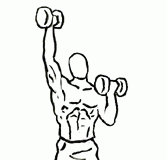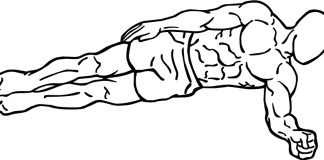Last Updated on September 30, 2014
The front squat with barbell is a powerful compound exercise that targets the lower body and core, similar to the traditional rear squat, but with a key difference: the placement of the barbell. By positioning the barbell on the front deltoids, this variation reduces strain on the spine and can be an excellent alternative for individuals with back and neck injuries. In this in-depth guide, we’ll explore everything you need to know about the front squat, from the muscles it targets to step-by-step instructions, tips for optimal performance, variations for all levels, and safety considerations.
What Is a Front Squat with a Barbell?
The front squat is a strength training movement that emphasizes the quadriceps, glutes, and core muscles. Unlike the back squat, where the barbell rests on the shoulders and upper back, the front squat places the barbell on the front deltoids and collarbone. This adjustment shifts the weight forward, requiring a more upright posture and greater core engagement, making it a safer option for those who want to minimize pressure on their lower back.
Muscles Worked During the Front Squat
The front squat is a compound movement that engages several major muscle groups:
- Quadriceps: The front squat is quad-dominant, meaning it places significant emphasis on the muscles at the front of your thighs. The quads are responsible for extending the knee during the upward phase of the squat.
- Glutes: The gluteus maximus, the largest muscle in your body, is heavily engaged as you lower yourself and push back up. Strong glutes contribute to better performance in other exercises and daily activities.
- Hamstrings: Although the front squat is less hamstring-focused compared to the back squat, these muscles still play a stabilizing role during the movement.
- Core Muscles: The front squat demands a strong and stable core to keep the torso upright and balanced. Your abdominals and obliques work hard to stabilize the spine and maintain posture.
- Upper Back and Shoulders: Holding the barbell in the front rack position activates the upper back muscles, such as the trapezius and deltoids, to stabilize the bar and keep it in place.
Benefits of the Front Squat with Barbell
The front squat offers a range of benefits that make it a valuable addition to your workout routine:
- Reduced Strain on the Spine: By positioning the barbell at the front of the body, the front squat decreases the compressive forces on the lower back. This makes it a safer option for individuals with back or neck issues, allowing them to perform squats without aggravating existing conditions.
- Improved Core Strength: The front squat requires significant core engagement to maintain an upright posture. As a result, it strengthens the abdominals, obliques, and lower back muscles, leading to improved stability and balance.
- Enhanced Quadriceps Development: The upright position shifts the focus to the quadriceps, making the front squat an effective exercise for building strong, defined legs.
- Functional Fitness: The front squat mimics many real-life movements, such as lifting objects or maintaining balance while carrying loads. Incorporating it into your routine can improve your functional strength and mobility.
- Flexibility and Mobility: Performing the front squat requires ankle, hip, and shoulder mobility. Regular practice can help improve these areas, leading to better overall movement patterns.
Step-by-Step Guide to Performing the Front Squat with Barbell
Executing the front squat with proper technique is essential for maximizing the exercise’s benefits and preventing injury. Follow these steps for a safe and effective front squat:
- Rack the Barbell: Set the barbell at chest height in a squat rack. Approach the bar and rest it across your front deltoids, allowing it to sit just above your collarbones. Your elbows should be pointed forward and up, creating a “shelf” for the bar.
- You can use one of two grips:
- Crossed Arm Grip: Cross your arms in front of your chest, securing the bar with your fingers. This grip is suitable for those with limited wrist flexibility.
- Clean Grip: Hold the bar with an underhand grip, keeping your elbows high. This grip requires greater wrist mobility but provides more stability.
- You can use one of two grips:
- Set Your Stance: Stand with your feet shoulder-width apart and your toes pointing slightly outward. Engage your core and keep your chest up.
- Unrack the Bar: Lift the bar off the rack and step back, maintaining an upright posture. Ensure your core is tight, and your elbows remain elevated to keep the bar secure.
- Lower into the Squat: Slowly bend your knees and hips to lower your body. Aim for your thighs to be parallel to the floor, keeping your back straight and your torso upright. Your elbows should stay high to prevent the bar from rolling forward.
- Drive Back Up: Push through your heels and extend your legs to return to the starting position. Focus on squeezing your glutes and engaging your quads as you rise.
- Repeat: Perform the desired number of repetitions while maintaining proper form throughout each rep.
Pro Tip: If you’re new to the front squat, practice the movement without any weight first to build confidence and ensure proper technique before adding a barbell.
Tips for Maintaining Proper Form
Front squats can be challenging, especially for beginners, but these tips will help you perform the exercise safely and effectively:
- Warm Up Properly: Warm up with dynamic stretches that focus on hip mobility, ankle flexibility, and shoulder rotation. Movements like lunges, leg swings, and arm circles prepare the muscles and joints for squatting.
- Engage Your Core: A strong core is crucial for stabilizing your torso and preventing your back from rounding. Keep your abs tight throughout the movement.
- Focus on Elbow Position: Keeping your elbows high is essential for maintaining the bar’s position. If your elbows drop, the bar may roll forward, compromising your form and safety.
- Keep Your Heels on the Ground: Make sure your heels stay planted during the entire movement. Rising onto your toes can throw off your balance and reduce the effectiveness of the exercise.
- Control the Descent: Lower yourself slowly to fully engage your muscles and maintain control. Avoid “dropping” into the squat, as this can lead to injuries.
Common Mistakes and How to Avoid Them
To get the most out of the front squat, it’s important to be aware of common mistakes:
- Rounding the Back: Leaning forward or rounding your back puts unnecessary strain on the spine. Keep your chest lifted and focus on maintaining a neutral spine.
- Dropping the Elbows: If your elbows fall during the squat, the bar may roll forward, compromising your balance and technique. Practice keeping your elbows high throughout the entire movement.
- Incorrect Foot Placement: Placing your feet too close together or too wide apart can affect your balance. Aim for a shoulder-width stance with toes slightly outward to maintain stability.
- Using Excessive Weight Too Soon: Start light and focus on mastering the form before increasing the weight. Progress gradually to avoid straining your muscles and joints.
Variations of the Front Squat for All Levels
To keep your workouts dynamic and cater to different fitness levels, try these variations of the front squat:
- Bodyweight Front Squat: Perfect for beginners, this variation allows you to focus on proper form without the added weight. Practice the movement using just your body weight until you feel comfortable.
- Kettlebell Front Squat: Hold a kettlebell at chest height, using both hands. This variation challenges your core and balance, making it a great progression for those new to squats.
- Goblet Squat: Hold a dumbbell or kettlebell in front of your chest like a goblet. This variation emphasizes the same muscle groups as the barbell front squat and helps build confidence with weight before transitioning to a barbell.
- Single-Arm Dumbbell Front Squat: Hold a dumbbell in one hand at shoulder height and squat. This version challenges your stability and engages the core muscles more intensely.
- Elevated Heel Front Squat: Elevating your heels slightly using a weight plate or wedge can help improve depth and reduce the strain on your ankles, making it easier to squat with proper form.
Incorporating the Front Squat into Your Workout Routine
The front squat is versatile enough to fit into various workout programs:
- Strength and Hypertrophy: For building strength, perform 3-4 sets of 6-8 reps with heavy weights. For muscle growth (hypertrophy), aim for 8-12 reps with moderate weight and shorter rest periods (60-90 seconds).
- Functional Fitness Circuits: Include front squats in circuit training for a full-body workout. Pair them with lunges, deadlifts, and overhead presses to target multiple muscle groups and boost cardiovascular fitness.
- Lower Body Focus: On leg days, use front squats alongside lunges, step-ups, and Romanian deadlifts for a comprehensive lower body workout that builds strength and stability.
Safety Considerations
Safety is paramount when performing any squat variation:
- Warm-Up: Start with dynamic stretches and bodyweight exercises to prepare your muscles and joints.
- Gradually Increase Weight: Progressively add weight only when you’re confident in your form.
- Use a Spotter or Safety Rack: When lifting heavier weights, always use a spotter or set the safety bars in the squat rack to catch the bar if you lose balance or cannot complete the lift. This is especially important when training alone.
- Proper Footwear: Wear stable, flat shoes or lifting shoes designed for squatting. These provide the necessary support and stability, unlike running shoes, which can be too cushioned and lead to balance issues.
- Monitor Your Form: If possible, perform front squats in front of a mirror or record yourself to monitor your technique. Observing your form can help you identify any issues, like leaning forward or dropping the elbows, and correct them before they lead to injury.
Frequently Asked Questions About Front Squats
1. Can front squats replace back squats in my routine?
Front squats can be a great alternative to back squats, especially if you have lower back or shoulder issues. They emphasize the quadriceps and core more directly, providing a different muscle engagement. However, if you aim for balanced leg development, incorporating both front and back squats can be beneficial.
2. How often should I do front squats?
It depends on your goals and overall workout program. Front squats can be done 1-2 times a week as part of your leg or full-body workout routine. Ensure you allow at least 48 hours of rest between sessions to give your muscles time to recover and grow.
3. Is it normal to feel pressure on my wrists during front squats?
Yes, it is common, especially if you use the clean grip. Wrist flexibility is key in this position. If you experience discomfort, you can try the crossed-arm grip or work on wrist mobility exercises to improve flexibility over time.
4. How deep should I squat in a front squat?
Aim to lower your upper thighs until they are parallel to the floor or slightly below. However, the depth may vary based on individual flexibility and mobility. It’s important to maintain proper form; avoid going so deep that your back rounds or your heels lift off the ground.
5. What is the difference between front squats and goblet squats?
Goblet squats involve holding a dumbbell or kettlebell in front of your chest, making it easier to maintain an upright posture. They are great for beginners and can serve as a precursor to barbell front squats. Front squats, on the other hand, involve a barbell and allow for heavier weights, challenging the upper body more to stabilize the load.
6. Can front squats help with back pain?
Front squats can be beneficial for individuals with lower back pain as they reduce the compressive forces on the spine compared to back squats. However, it’s important to consult a healthcare professional or physical therapist if you have a history of back injuries. They can assess your condition and guide you on whether front squats are suitable for your situation.
Advanced Techniques and Variations for Experienced Lifters
For advanced lifters looking to challenge themselves further, the front squat can be modified to increase difficulty and target different muscle fibers:
- Tempo Front Squats: Incorporate a controlled tempo by taking 3-4 seconds to lower into the squat and 1-2 seconds to rise. This emphasizes muscle engagement and builds strength.
- Pause Front Squats: At the bottom of the squat, hold the position for 2-3 seconds before returning to the starting position. Pausing increases time under tension, challenging your strength and stability.
- Band-Resisted Front Squats: Attach resistance bands to the barbell and squat rack. This variation adds resistance as you rise, making it more challenging and effective for building explosive power.
- Front Squat with Chains: Adding chains to the barbell increases the weight as you ascend. This variation is commonly used by powerlifters to develop strength throughout the entire range of motion.
- Elevated Heel Front Squats: Elevating your heels on weight plates can help target the quadriceps more directly and improve squat depth. This modification is great for lifters who struggle with ankle mobility.
Front Squats as Part of a Balanced Workout Program
The front squat is a versatile exercise that fits well into various training programs, whether you’re focusing on strength, hypertrophy, or functional fitness. Here are a few examples of how you can incorporate front squats:
- Strength Training Program:
- Warm-Up: 10 minutes of dynamic stretches and mobility drills.
- Set 1: Front Squats – 4 sets of 5-6 reps (heavy weight, focus on strength).
- Set 2: Romanian Deadlifts – 4 sets of 6 reps (to target hamstrings and glutes).
- Set 3: Lunges – 3 sets of 8 reps per leg.
- Set 4: Calf Raises – 3 sets of 12 reps.
- Cool Down: 5-10 minutes of static stretches, focusing on hamstrings and hip flexors.
- Hypertrophy Program:
- Warm-Up: 10 minutes of dynamic stretches and leg activation exercises.
- Set 1: Front Squats – 3 sets of 8-12 reps (moderate weight, focus on muscle growth).
- Set 2: Bulgarian Split Squats – 3 sets of 10 reps per leg.
- Set 3: Step-Ups with Dumbbells – 3 sets of 12 reps per leg.
- Set 4: Leg Press – 3 sets of 15 reps.
- Cool Down: 5-10 minutes of stretching with a focus on quads and calves.
- Functional Fitness/Conditioning Program:
- Warm-Up: 10 minutes of mobility drills and light jogging.
- Circuit 1:
- Front Squats – 15 reps
- Box Jumps – 15 reps
- Kettlebell Swings – 15 reps
- Rest for 1 minute, repeat 3 times.
- Circuit 2:
- Walking Lunges – 12 reps per leg
- Single-Leg Deadlifts – 12 reps per leg
- Burpees – 12 reps
- Rest for 1 minute, repeat 3 times.
- Cool Down: 5-10 minutes of full-body stretches.
The front squat with barbell is an incredibly effective exercise for building lower body strength, core stability, and functional fitness. Its versatility makes it suitable for everyone, from beginners looking to develop basic squat mechanics to advanced lifters seeking new challenges. By reducing the strain on the lower back and neck, the front squat provides an alternative for those dealing with injuries or looking to vary their routine.
To get the most out of the front squat, remember to focus on form, progress gradually with weight, and incorporate different variations to keep your workouts engaging and challenging. With consistency and proper technique, the front squat can become a key element of your training program, helping you achieve your fitness goals safely and effectively.
Exercise images by Everkinetic.







